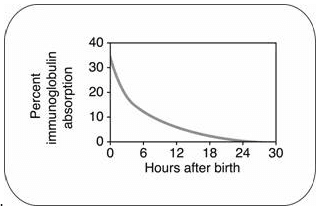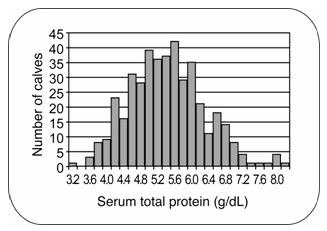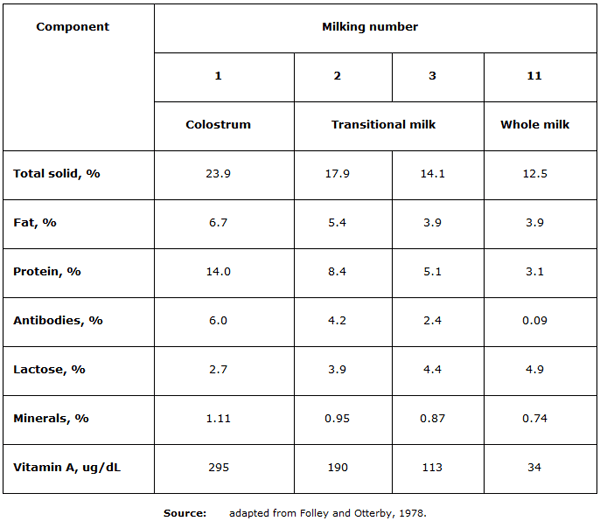The success of colostrum feeding to calves is built on four critical components:
- Timing - How quickly the calf receives colostrum after birth.
- Quantity - How much colostrum the calf receives.
- Quality - The concentration of immunoglobulins in the colostrum.
- Cleanliness - The levels of pathogens in the colostrum.
Introduction
The most important factor in dairy calf health and survival is feeding the newborn calf adequate amounts of high-quality colostrum early in its life. The cost of raising replacement dairy animals increases if calf-rearing results in higher-than-normal mortality or requires medicine to treat preventable diseases.
At birth, a calf has a poorly developed immune system. The placenta does not allow the transfer of antibodies, also known as immunoglobulins (Ig), from the mother to the fetus during pregnancy. True colostrum is the "first milk", which is rich with the antibodies that provide the calf protection from diseases in early life until the calf´s own immune system becomes functional. Colostrum is also important as the first source of nutrients after birth.
Antibodies are proteins that identify and destroy disease-causing organisms, or pathogens, in the calf. Three major types of Ig (G, M and A) are typically found in the colostrum of dairy cows in percentages of 85%-90%, 5%-10% and 5%-10%, respectively.
The three types of immunoglobulins have specific roles in the immune system. The primary role of IgG is to identify and help destroy invading pathogens. IgG can move out of the bloodstream and into other areas of the body where it helps identify pathogens. The principal role of IgM is to identify and destroy bacteria that have entered the blood. IgA attaches to the membranes that line many organs, such as the intestine, and prevents pathogens from attaching and causing disease.
Timing
Timing is critical to a successful colostrum-feeding management program. The ability of a calf's small intestine to absorb immunoglobulins drops rapidly over the first few hours of life. By 24 hr of age, the ability to absorb immunoglobulins is nearly nonexistent, as shown in Figure 1. If a calf has not received any colostrum within 12 hr of birth, it is unlikely to be able to absorb enough antibodies to have adequate immunity. For this reason, a calf should receive the first feeding of colostrum within 1 hr of birth when possible
Figure 1. The ability of a calf to absorb immunoglobulins declines rapidly after birth.
Passive immunity is the temporary protection that the calf receives from the cow through the transfer of maternal antibodies present in colostrum. Passive immunity protects the calf until its own immune system becomes active. With active immunity, an older calf is mature enough to produce antibodies in response to vaccinations or to fight infections that it is exposed to.
Figure 2. Refractometry readings for 422 calves aged 0-8 days on 116 southern Ontario dairy farms.
Source: Trotz-Williams et al., 2006.
The goal for proper colostrum feeding is for the calf to achieve a minimum blood serum IgG level greater than 10 mg/mL. As an alternative to testing for serum IgG levels, serum total protein levels may be measured. A serum total protein level of 5.2 g/dL is considered equivalent to the serum IgG level of 10 mg/mL.
"Failure of passive transfer" (FPT) occurs when the acceptable levels of total protein or IgG are not achieved by 24-48 hr after birth. Canadian and American reports often show that as many as 35%-40% of dairy calves suffer from FTP, which indicates that many calves have inadequate immunity and are more likely to get sick. A recent study reported serum total protein levels in Ontario dairy calves, shown in Figure 2; approximately 35% of calves had FPT.
It is accepted that the higher the concentration of IgG or serum total protein levels in the calf 48 hr after birth, the greater the protection the calf has against disease pathogens.
A study by the U.S. National Animal Health Monitoring System found that calves with low immunoglobulin levels in their blood 2 days after birth had a death rate over the next 8 weeks that was more than twice that of calves with acceptable levels of serum immunoglobulins (see Figure 3).
Figure 3. Survival of calves with inadequate serum immunoglobulin concentrations is reduced, compared with calves having acceptable levels of immunity.
Source: National Dairy Heifer Evaluation Project, NAHMS, 1992.
Quantity
The best practice is to feed 4 L of high-quality colostrum to Holstein calves within 1 hr of birth. A second feeding of 2?3 L of colostrum should be given within the next 8 hr. Calves that are bottle-fed colostrum have a better chance of receiving enough immunoglobulins than calves left to nurse from their mother. Calves that fail to drink on their own within 3 hr of birth should be given colostrum by esophageal feeder.
Quality
The immunoglobulin content in the first "milking" colostrum is typically 5%-6% (50-60 g/L), but can range from less than 2% (20 g/L) to greater than 15% (150 g/L).
The concentration of antibodies in colostrum decreases rapidly with each milking as the transition from colostrum to milk production occurs. Usually, the second milking has 65% as much immunoglobulins as the first milking. By the third milking, the level has fallen to 40% of the first milking. Some differences in the composition between true colostrum, transitional milk and whole milk are shown in Table 1.
Nutrients in colostrum, such as fat and protein, are also important to the calf for growth and development. The lactose concentration in colostrum is less than is present in whole milk, which reduces the chance of diarrhea in the newborn calf.
Dairy breeds produce lower concentrations of immunoglobulins in their colostrum than beef breeds. Among the common dairy breeds, Holsteins tend to have the lowest level and Jerseys the highest.
Table 1: Typical analysis of colostrum, transitional milk and whole milk from Holsteins
First-lactation heifers usually have lower levels than older cows that are in their third or greater lactation. Cows that have had less than a 4-week dry period usually have lower levels of antibodies.
Cleanliness
A significant challenge of colostrum feeding is keeping it clean. While feeding colostrum is essential to provide passive immunity for the calf, it is also one of the first ways to potentially expose the calf to such pathogens as E. coli, Salmonella or Mycobacterium avium paratuberculosis, the bacterial species responsible for Johne's disease. Pathogens can also cause diseases such as scours and septicemia and may interfere with passive absorption of the antibodies from the gut into the circulation system. Clean udders, milking equipment and calf-feeding equipment well before harvesting, storing and feeding colostrum.
Feed calves colostrum that has a total bacteria count of less than 100,000 colony-forming units (CFU)/mL and a total coliform count of less than 10,000 CFU/mL.
An Ontario study in 2002 found that 12% of colostrum samples had high levels of bacteria. The study concluded that the source of the bacteria was from either a dirty udder or dirty collection container. Similarly, results from a recent U.S. study reported bacterial results from the colostrum on 12 dairy farms. In that study, the average total plate count was 16.1 million CFU/mL, and the total coliform count was 2.7 million CFU/mL, indicating that dairy farmers should pay more attention to colostrum cleanliness.
Storage
Colostrum can be refrigerated cold at 1°C-2°C (33°F-35°F) for up to a week or kept frozen at -20°C (-4°F) for up to year. Avoid frost-free freezers. Two-litre plastic containers or freezer bags are ideal. If using freezer bags, double-bag the colostrum.
Thaw the colostrum in 50°C (120°F) water. Do not thaw at room temperature, as bacteria double every 20-30 min. at room temperature.
Colostrum can also be thawed in a microwave, with care. Microwave the colostrum on low for short periods of time. Avoid hot spots and mix partially thawed containers if necessary.
Recent research at the University of Minnesota found that colostrum can be heated to 60°C (140°F) without damaging the antibodies. However, when the colostrum was heated to 63°C (145°F), the antibodies were reduced by 34%.
Do not mix colostrum from two or more cows.
Colostrum can also be pasteurized on farm to reduce the presence of pathogens. The newer pasteurization equipment is convenient to use. It can provide a very effective method of reducing pathogens to improve colostrum cleanliness and dramatically reduce the potential for diseases to be transmitted by feeding colostrum. It is important to keep pasteurization equipment clean and to follow manufacturer´s directions for both temperature and time of treatment so as not to destroy the antibodies present in the colostrum. Pasteurizing colostrum significantly reduces the level of bacteria present. However, to reduce bacterial regrowth, pasteurized colostrum must be properly stored, as described above, until it is fed.
As a final alternative, if sufficient amounts of high-quality colostrum are not available, commercial colostrum supplements can be a valuable tool for increasing calf immunity or for use as a disease-management strategy when transmission of disease from the mother to the calf is an issue. In the U.S., some colostrum supplements use bovine serum as the source of immunoglobulins. These products have not been approved in Canada, and their ability to achieve satisfactory immune status in dairy calves is debatable. Maternal colostrum replacement products prepared from colostrum from healthy cows are available in Canada, and published research supports its effectiveness at increasing immunity protection in dairy calves.
Follow manufacturer's directions with these products.
Testing
Testing equipment can be purchased from a number of farm suppliers.
A colostrum hydrometer, often called a Colostrometer®, estimates the immunoglobulins in the colostrum by measuring the specific gravity of colostrum. Accurate measurements require that the temperature of the colostrum be correct, typically, at room temperature. Higher or lower temperatures result in incorrect readings. Follow manufacturer's directions. Some manufacturers provide information to adjust readings if tested at other temperatures.
Readings of more than 50 g/L for colostrum IgG concentrations are desirable.
Refractometers are commonly used by veterinarians to evaluate the degree of passive transfer in calves. Refractometers are used to estimate the total serum protein level in the calf. Readings of 5.2 g/dL or greater indicate successful passive transfer.
Summary
Colostrum is the critical first step to the health and survival of newborn calves. The successful transfer of the antibody protection in colostrum from cow to calf is based on four key factors:
- How quickly the calf receives colostrum after birth - within 1 hr is best.
- How much colostrum the calf receives - 4 L at first feeding.
- The immunoglobulin concentration in the colostrum.
- Low levels of pathogens in the colostrum.
References
Davis CL, Drackley JK. 1998. The development, nutrition and management of the young calf. Iowa University State Press.
Foley JA, Otterby DE. 1978. Availability, storage, treatment, composition and feeding of surplus colostrum: A review. J Dairy Science 61(8):1033-1060.
Johnson JL, Godden SM, Molitor T, Ames T, Hagman D. 2007. Effects of feeding heat-treated colostrum on passive transfer of immune and nutritional parameters in neonatal dairy calves. J Dairy Science 90:5189-5198.
McMartin S, Godden S, Metzger L, Feirtag J, Bey R, Stabel J, Goyal S, Fetrow J, Wells S, Chester-Jones H. 2006. Heat treatment of bovine colostrum. I: Effects of temperature on viscosity and immunoglobulin G level. J. Dairy Science 89:2110-2118.
National Animal Health Monitoring System. 1993. Transfer of maternal immunity to calves. National Dairy Heifer Evaluation Project, USDA.
Quigley J. 2001. CalfNotes # 3 -A primer on colostral immunoglobulins. www.calfnotes.com.
Tyler JW, Hancock DD, Parish SM, Rea DE, Besser TE, Sanders SG, Wilson LK. 1996. Evaluation of three assays for failure of passive transfer in calves. J. Veterinary Internal Medicine 10(5):304-307.
Trotz-Williams L, Leslie K, Peregrine A. 2006. Passive immunity in Ontario dairy calves and the influence of calf management. Dairy and Veal Calf Conference 2006.
This article was originally published in The Ontario Ministry of Agriculture, Food and Rural Affairs (OMAFRA) website, http://www.omafra.gov.on.ca. Last reviewed June 2010. Engormix .com thanks for this huge contribution.









.jpg&w=3840&q=75)




.jpg&w=3840&q=75)